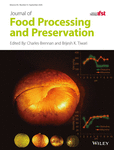Physicochemical properties, rheology, and storage stability of salad creams made from different cassava starch varieties
Abstract
The use of cassava starch as potential substitute for corn starch in the production of salad cream (SC) may contribute to sustainable utilization of cassava roots. This study investigated the physicochemical properties, rheology, and storage stability of SC made with starches from eight cassava varieties. SC produced was stored in an airtight plastic jar for 3 months at ambient temperature (25 ± 2°C). Changes in the physicochemical properties, rheology, and storage stability of the stored SC samples were determined using standard methods. There was a significant decrease (p < .05) in the solid contents of the SC while the peroxide increased with storage period. There was a significant increase (p < .05) in the total plate count (TPC) of the SC samples with storage period. This study further showed that the SC samples were all chemically and microbially stable considering the standards for peroxide value (PV) (<10 meg/kg) and TPC (<104 cfu/g) within the 3 months storage.
Practical applications
The salad cream (SC) consumed in Nigeria is mainly imported and expensive. Local brands of the product are scarce in the grocery. SC is produced majorly from modified corn flour or starch with other ingredients. To make local manufacture of SC economically feasible, it is practically imperative to find a locally available replacement for corn starch. This study was then conceived to screen starches from some elite cassava varieties for use in SC production. It has been established from this study that the cassava starches tested could be a suitable substitute for corn starch for the production of SC. However, the most stable SC from textural point of view was derived from a yellow fleshed cassava variety (TMS 1206), which is very important for the consumer preference. With appropriate addition of other ingredients in the production, consumers are assured of best quality SC.
CONFLICT OF INTEREST
The authors have declared no conflicts of interest for this article.




